I regularly get asked for several graphics from the State of Our Gulf 2020 so I am posting them here so everyone can access them.












Mostly just stuff I am doing to help the planet
I regularly get asked for several graphics from the State of Our Gulf 2020 so I am posting them here so everyone can access them.












Commercial bottom trawling and Danish seining. The Sea Change – Tai Timu Tai Pari Marine Spatial Plan 2016 (Sea Change) recommend these fishing methods be removed from the Gulf, this is inline with the Hauraki Gulf Forums (The Forum) goals. It is disappointing to see the Government push any decision to another committee, however they have suggested ‘most’ trawling will stop which is hopeful. Currently both practices impact about 77% of the Gulf.
Commercial dredging. Sea Change and the Forum also recommend this destructive practice be removed from the Gulf. No changes here with huge heavy machines scraping ~37% of the seafloor. In 2016 current Minister of Oceans David Parker said “Fisheries New Zealand has been captured by industry” it seems that has not changed with Mr Parker now heading up the portfolio. I am hoping the areas are reduced in the Fisheries Management Plan as most of the effort (~300 tows PA) currently happens around the Mercury Island Group.
Recreational dredging. Stopping this is a huge win for the Gulf, it opens up the entire Inner Gulf for restoration and I think it should have been the headline. However I think its unlikely that recreational fishers will think this is fair given commercial dredges have much more impact on the seafloor. The Inner Gulf is much more degraded by bottom impact fishing than the Outer Gulf with over 122 years of scraping. It’s really exciting that from 2024 it can begin the long process of recovery.
Marine Protected Areas. No take marine reserves go from 0.33% to 0.575% of the Gulf. This is a significant increase, but a pathetic overall result. Experimental ‘High Protection Areas’ with customary take by permit will attempt to protect 6.2% of the Gulf. These areas will not come into effect until the end of 2024. I expect we will have to wait at least seven years before we know if they work.
Fisheries Management Plan. Also pushed to another committee. I am deeply concerned that the changes above will not arrest the decline of the Gulf especially with looming climate change impacts. The entire approach is relying heavily on the Fisheries Management Plan which they claim will be ecosystem based.
Existing ‘No Take’ Marine Protected Areas in the Gulf:
| Cape Rodney-Okakari Point Marine Reserve | 5.6km2 |
| Te Whanganui A Hei (Cathedral Cove) Marine Reserve | 8.8km2 |
| Long Bay-Okura Marine Reserve | 9.6km2 |
| Motu-Manawa-Pollen Island Marine Reserve | 5km2 |
| Te Matuku Marine Reserve | 6.9km2 |
| Tāwharanui Marine Reserve | 4km2 |
| TOTAL | 39.9km22 |
Sea Change ‘No Take’ extensions
| Whanganui-a-Hei (Cathedral Cove) Marine Reserve | +15 km2 |
| Cape Rodney-Okakari Point (Leigh) Marine Reserve | +14 km2 |
| TOTAL | 29km2 |
The Hauraki Gulf Marine Park is 12,000km2 or 14,000 km2 of ocean depending on what you read, I’m choosing the smaller number.
Sea Change brings ‘No Take’ Marine Protection in the Gulf from 40km2 to 69km2 or from 0.33% to 0.575%.
The other 11 proposed High Protection areas are experimental in that they allow customary take by permit. They could meet the protection level required to be designated as MPAs, depending on how mana whenua choose to undertake their customary practises. They are:
| Te Hauturu-o-Toi/Little Barrier Island | 195.4km2 |
| Slipper Island/Whakahau | 13.5km2 |
| Motukawao Group | 29.1km2 |
| Firth of Thames and Rotoroa Island | 12.4 km2 |
| Rangitoto Island and Motutapu Island | 10.7km2 |
| Cape Colville | 26.7 km2 |
| Mokohinau Islands | 118.5km2 |
| Aldermen Islands | 133.9 km2 |
| Aldermen Islands South | 155.0 km2 |
| Kawau Bay | 40.4 km2 |
| Tiritiri Matangi Island | 9.5 km2 |
| TOTAL | 745.1km2 |
Or 6.2% of the Gulf.
The technical analysis of the proposals has assumed that these areas will be ’No Take’ but Government has decided to use special legislation to progress the ‘High Protection Areas’ rather than the Marine Reserves Act, there is no indication as to why. The areas which will be enabled through new legislation which will not be passed until 2024, this means the process which started in 2013 when completed will have taken 11 years. As the areas include customary take by permit, they are experimental. I don’t know how long we will then have to wait until we know if the experiment works or not. I am deeply concerned it’s not even close to enough protection to restore functioning ecosystems in the Gulf. The existing reserves and extensions plus the High Protection Areas only add up to 6.775% of the Gulf (excluding any seafloor protection like cable zones). The Government is putting a lot of faith in a Fisheries Management Plan that does not yet exist.
Errors (as I find them):
Page 39. “Since then, large scallop and oyster beds have largely replaced mussel beds in areas of habitat degradation.” The areas are dominated by mud, invasive species are the dominant epifauna.
Page 39. “Significantly increasing the amount of freshwater” sentence is not finished or doesn’t make sense.
Page 107. Climate change resilience excluded from Draft Fisheries Management Plan. Incredible that in 2021 a Govt department can still make a plan that excludes known climate change impacts.
UPDATE 23 July: MAC report released
The Ministerial Advisory Committee was not impressed with the first draft of the action plan, and it looks like many changes were made. However it is hard to tell what was changed as (like the action plan itself) it is very short on detail. The biggest criticism seems to be on the timings which I really agree with, Govt is moving incredibly slowly given the urgency of the problem.
The other general criticism is around resourcing. This paragraph well articulates my frustration in reading the ‘active restoration’ section of the report.
“Our major concern with this part of the strategy is a complete lack of reference to funding sources for restoration. While identifying regulatory barriers is mentioned, there is no mention of funding barriers, which are arguably just as significant. Active restoration efforts will require resources to implement and sources of funding should be identified.”
I am very pleased to see that Govt listened to one member of the MAC that questioned blanket customary take in the MPAs. I hope many iwi will support no-take in HPAs because they will want them to have maximum mauri, and only no-take MPAs are known to work – anything else is an experiment.
A lot of the rest of the criticism is around governance. I am not interested in ownership of the Gulf or the power dynamics… just environmental outcomes.
UPDATE 30 July: OIA on dredging areas refused
OIA response here. I have emailed the officer to ask for the survey results and a follow up meeting.
UPDATE 6 August 2022:
I got no response, so sent in a new OIA request for the data and survey. I then got a phone call. They are 6-8 weeks away from publishing the NIWA HGMP scallop fishery survey results (so my request for those will be declined). Aggregated Electronic Catch and Position Reporting (ER/GPR) data would be available if I provided a specific time frame and area. The data could be provided visually E.g. a heat map. I have done this.
I was also informed that the conversation around management options for the scallop fisheries is internal, management options will not be made public but will be provided to the Minister in several months.
UPDATE 6 September 2022
I received a response to my OIA request (Heatmap A, Heatmap B). I have added the dredged areas together and removed the proposed HPA’s, SPA’s and CPZ’s to calculate the percent of the HGMP that will be ‘frozen’ under the Governments plan to ‘revitalise the Gulf‘. More than 20% of the Gulf will remain heavily impacted by commercial dredging with no public input into the decision.
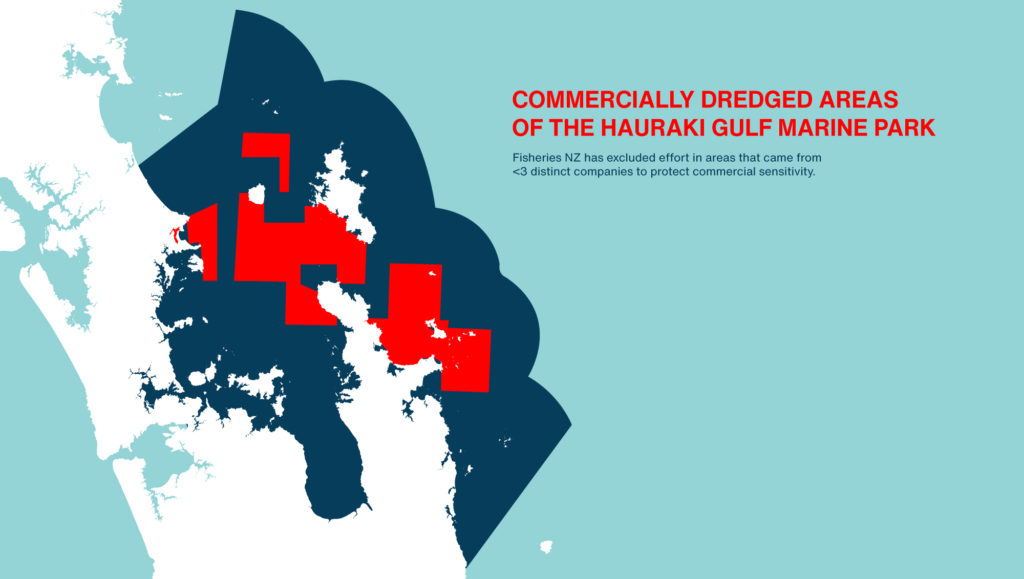
Update 28 September 2022:
The cost to create $774.1km2 of Marine Protection Areas in the plan (assuming they are no-take) to 11 commercial fish species was calculated to be $3,436,014. If we crudely scale up the figure for the gains to snapper / tamure alone based on this paper we get $209,710,000. Or a net gain of more than 200 million dollars! This is an incredible number, MPAs would not be adding so much money to commercial fisheries if they did not manage fish levels at such incredibly low numbers. Clearly Fisheries New Zealand should be making MPAs (at speed) all around NZ.
Update 28 October 2022:
Our painfully detailed submission on the marine protection proposals.
Here is my submission on the proposed Waikato Regional Coastal Plan.
TL;DR Less mapping, more controlling the effects of fishing.
Second submission after further consultation.
While researching my latest nature report to the Tahuna Torea Residents and Rangers I found some great bird counts in the reserve made in the 1980’s that had been entered on eBird. Unfortunately an oversight in the design of the website means you need to know a statistical programming language to extract population trend data for a location (however if you are able to stumble across an old checklist you can download the data). At the meeting Chris Barfoot supplied me with a brilliant 1993 report on the reserve which had a new set of data recorded by Micheal Taylor.
This new data adds valuable insight into the decline of waders in the Tamaki Estuary which the Tamaki Estuary Environmental Forum has recently published an article on. I have compiled the data and plotted it for key species below.

UPDATE 23 JUNE 2021. Here is an interesting snippet of history complied by the Howick & Pakuranga Times “Kuaka [bar tailed godwits] and red knots gather on the Cockle Bay estuary in thousands before flying to Korea and on to Alaska to breed each March, to return in September. In February-March they swoop over Point View ridges where farmers used shotguns before the birds were protected in 1941. They were plucked and preserved in their fat in ceramic jars.” Source: https://www.birdingnz.net/forum/viewtopic.php?f=3&t=11024
UPDATE August 2021. More data found in old journals. Graphs updated and presented to the Ōrākei Local Board.

I have begun doing some work with the Northern New Zealand Seabird Trust who invited me to come and help them with some field work on the Poor Knights Islands. My father had visited the Islands when he worked for DOC in the 1990’s, his stories about the reptile abundance really inspired me to do restoration work, and I jumped at the opportunity to go.
Landing on the Island is notoriously difficult and our first shot at it was delayed, we had to go back to Auckland to wait for better weather. The islands are surrounded by steep cliffs that made European habitation impractical, Māori left the area in the 1820’s. This means the island I visited has never had introduced mammals, not even kiore! I spent days cleaning my gear to get through the biosecurity requirements which are incredibly strict for good reason.

I have explored a few predator free islands including Hauturu / Little Barrier Island which has been described as New Zealand’s most intact ecosystem. However it was only cleared of rats in 2004. When I am photographing invertebrates at night in mainland sanctuaries or forests with predator control (like Tāwharanui Regional Park or parts of the Waitakere Ranges) I see one reptile every eight hours or so. On Hauturu / Little Barrier Island I see them every 20 minutes, but on the Poor Knights it was every two minutes! Bushbird numbers were lower than other islands, I expect this is because reptiles and birds compete over prey species. I wonder if reptile numbers on other islands might be slower to recover because they are preyed on by bushbirds. I reckon that the Poor Knights total reptile and bushbird biomass is much greater than the restored islands I have visited. One reason for this is that reptiles use less energy to hunt than bushbirds but the other reason might be because it has more seabirds.
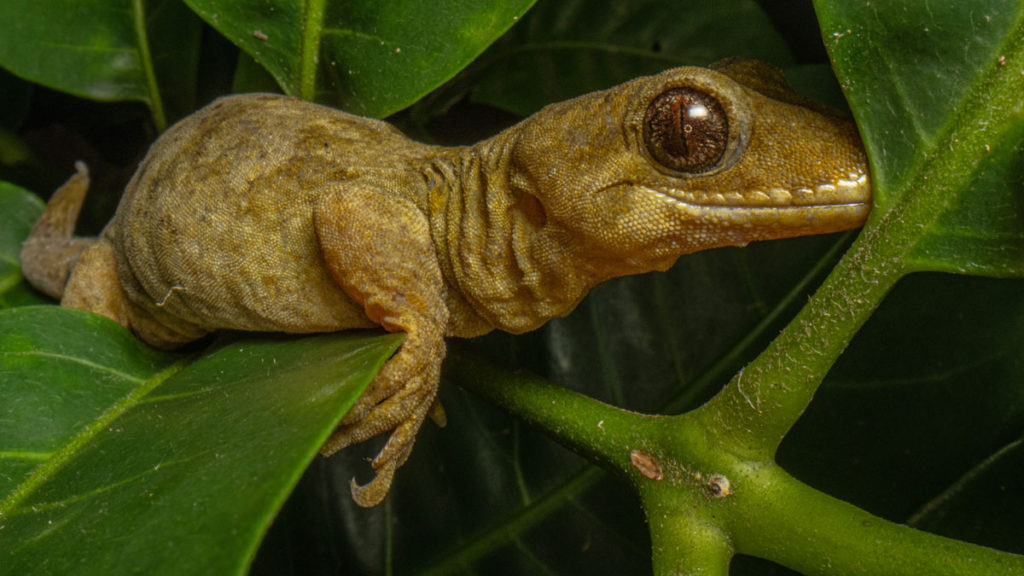
While walking through the bush at night I would sometimes hear a crashing in the canopy followed by a soft thump on the ground. In an incredible navigational feat the seabirds somehow land only meters from their burrows. At night I heard Buller’s shearwater, grey-faced petrel, little penguins and diving petrel (fairy prion finish breeding in February). While monitoring birds at night I was showered with dirt by a Buller’s shearwater who was digging out a burrow. In my short time on the island I saw cave weta and three species of reptile using the burrows. Like a rock forest the burrows add another layer of habitat to the ecosystem. It was incredibly touching to see the care and compassion the researchers had for some of the chicks who were starving while waiting for their parents who often have to travel hundreds of kilometres to find enough food. The chicks who don’t make it die in their burrows and are eaten by many invertebrates, the invertebrates in turn become reptile or bushbird food. The soil on the island looked thick and rich, when it rains nutrients are bought down into the small but famous marine reserve which is teaming with life.
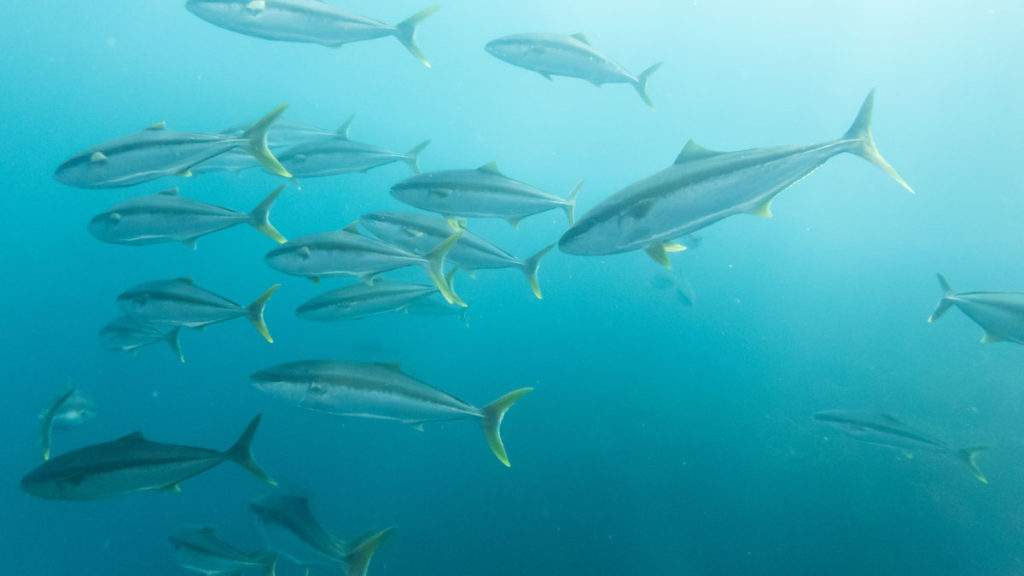
I was only on the island for three nights but I was very fortunate to experience a pristine ridge to reef ecosystem. Seabirds are incredible ecosystem engineers who were an integral part of New Zealand’s inland forests for millions of years. Communities are making small efforts to bring seabirds back to predator free island and mainland sites with no control over seabird food sources. If we really want intact ecosystems we will have to make sure our oceans have enough food for seabirds to feed our forests.
For the last eight years I have been working on restoring green-lipped mussel (perna canaliculus) beds in the Hauraki Gulf. The main reason we started with that species was that there is a commercial supply. However there is a bigger native mussel that has even more potential than green-lipped mussels, both as a habitat and water cleaner.
Horse mussels / Hururoa (atrina zelandica) are huge pumps, they are more than twice as big as green-lipped mussels (up to 400 mm in length) but have fragile shells which are vulnerable to fishing gear. They also don’t move (unliked green-lipped mussels) and are sensitive to changes in substrate.
Last century horse mussel beds were some of the best fishing spots in the Hauraki Gulf. I regularly ask divers about horse mussels; Where did you see them? How dense was the bed? etc. There are spots with horse mussel in the Gulf but I don’t know of any significant beds left, if you do, please let me know about them.
I was recently sent these images of a stunning horse mussel bed in Pakiri. They are from a report titled “Mangawhai – Pakiri Sand Study, Module 2: Technical Report, Marine Sands” by NIWA 1996. They show a large and dense horse mussel bed that has since been destroyed by sand mining. The beds ran the whole length of the embayment in depths of 15 -20m. I am posting them here to show the kind of seafloor we could have, if we treated it better.
We don’t yet understand the horse mussel lifecycle or what species / substates might attract juveniles. It’s interesting to note: presence of finger sponge and branching red algae, the hard edge to the bed and the way some of the shells align.
Overseas there have been attempts at restoring similar species (photos below). Seachange called for the “Initiation of a horse mussel restoration programme, with an initial focus on the Mahurangi and Whangapoua harbours.” But we could look at restoring any of the sites with historic beds. Wouldn’t it be awesome if we stopped smashing the seafloor, and bought back these giant pumps to clean the water, and create homes for fish.
In November I sent this letter to Auckland Councils Environment and Climate Change Committee along with this report. This morning I was invited to present to the Mayor of Auckland and the committee (presentation here) the report and letter were well received and I answered many questions from engaged Councillors. A response is being drafted.
I’m experimenting with mapping the seafloor for restoration projects. This is what I have done so far:



ArgiSoft Metashape worked much better than using Adobes photo stitching software (Photoshop & Lightroom) on the same data. But I need more overlapping images as all the software packages were not able to match all of any of the four test sequences I did.
I’m going to test shooting in video next. The frames will be smaller 2704×1520 (if I stick with linear to avoid extra processing for lens distortion) instead of 4000×3000 with the time-lapse but I’m hopping all the extra frames will more than compensate (2FPS=>24FPS).
In theory an ROV will be better but I don’t think there are any on the market that know where they are based on what they can see. All the work arounds for knowing where you are underwater are expensive, here are two UWIS & Nimrod. I want to see if we can do this with divers and no location data. I don’t think towing a GPS will be accurate enough to match up the photos but it does seem to work with drones taking images of bigger scenes (I want this to work in 50cm visibility). I expect if I want large complete images the diver will need to follow another diver who has left a line on the seafloor. One advantage of this is that the line could have a scale on it, but I’m hoping to avoid it as the lines will be ugly 😀 So far I can do only two turns before it fails. There are three patterns that might work (Space invaders, Spirals and Pick up sticks). For my initial trials I am focusing on Space invaders.
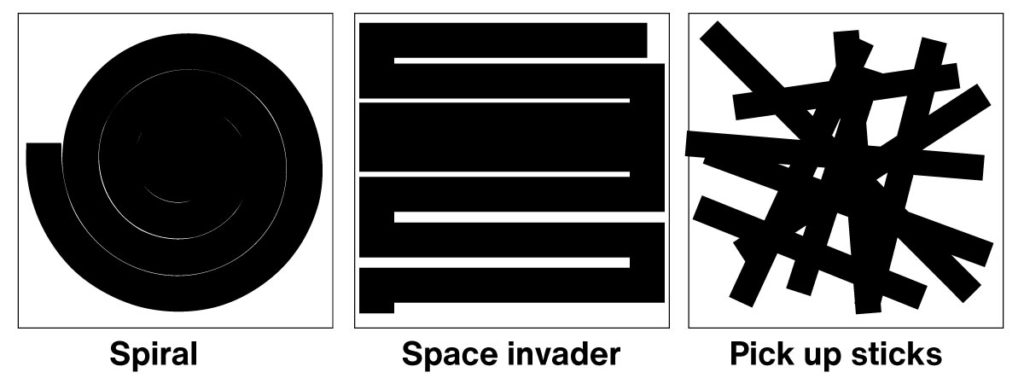
Video provides lots more frames and the conversion is easy. A land based test with GPS disabled, multiple turns, 2500 photos, 2704 x 2028 linear, space invader pattern at 1.2m from the ground worked perfectly. However I cant get it to work underwater. In every test so far Metashape will only align 50-100 frames. I tried shooting on a sunny day which was terrible as the reflection of the waves dancing on the seafloor confuses the software. But two follow up shoots also failed, when I look at the frames Metashape cant match I just don’t see why its can’t align them. Theses two images are in sequence, one gets aligned and the next one is dropped!
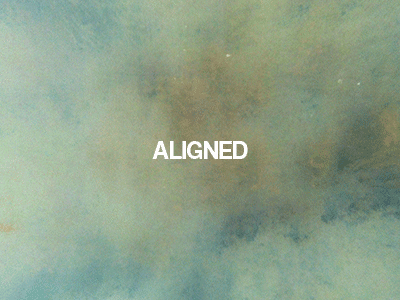
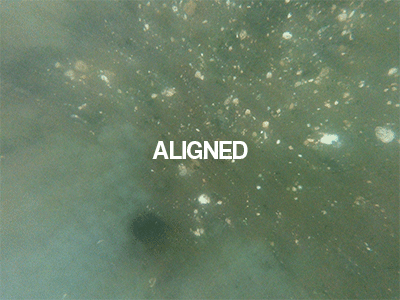
Here is what the test footage looks like, I have increased the contrast.
I have also tried exporting the frames at 8fps to see if the alignment errors are happening because the images are too similar but got similar results (faster).
Detailed advice from Metashape:
Since you are using Sequential pre-selection, you wouldn’t get matching points for the images from the different lines of “space invader” or “pick up sticks” scenarios or from different radius of “spiral” scenario.
If you are using “space invader” scenario and have hundreds or thousands of images, it may be reasonable to align the data in two iterations: with sequential preselection and then with estimated preselection, providing that most of the cameras are properly aligned.
As for the mesh reconstruction – using Sparse Cloud source would give you very rough model, so you may consider building the model from the depth maps with medium/high quality in Arbitrary mode. As for the texture reconstruction, I can suggest to generate it in Generic mode and then in the model view switch the view from Perspective to Orthographic, then orient the viewpoint in the desired way and use Capture View option get a kind of planar orthomosaic projection for your model.








Align ‘sequential’ only ever gets about 5% of the shots. Repeating the alignment procedure on ‘estimated’ picks up the rest but the camera alignment gets curved. I think I have calibrated the cameras to 24mm (it’s hard to see if that has been applied) but it doesn’t seem to change things.
I tried an above water test and made a two minute video of the Māori fish dams at Tahuna Torea. I used the same settings as above, but dropped the quality down to medium. It looks great!
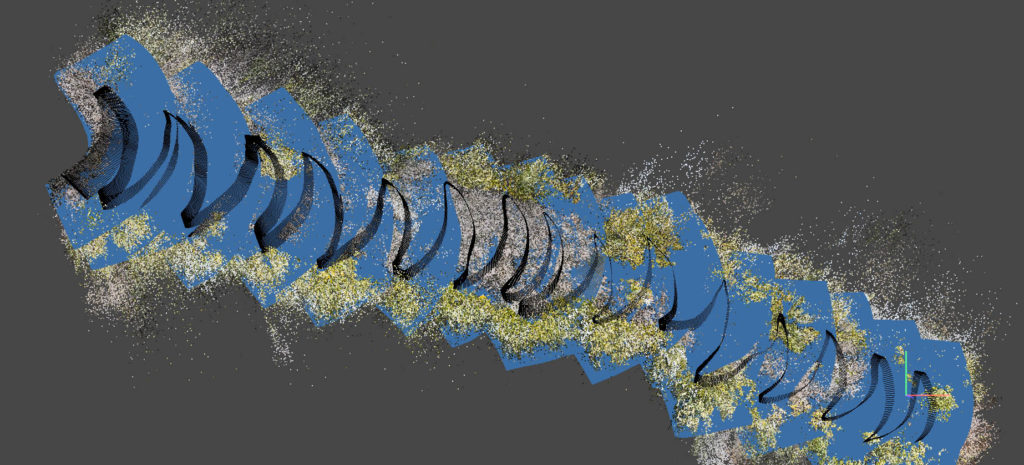
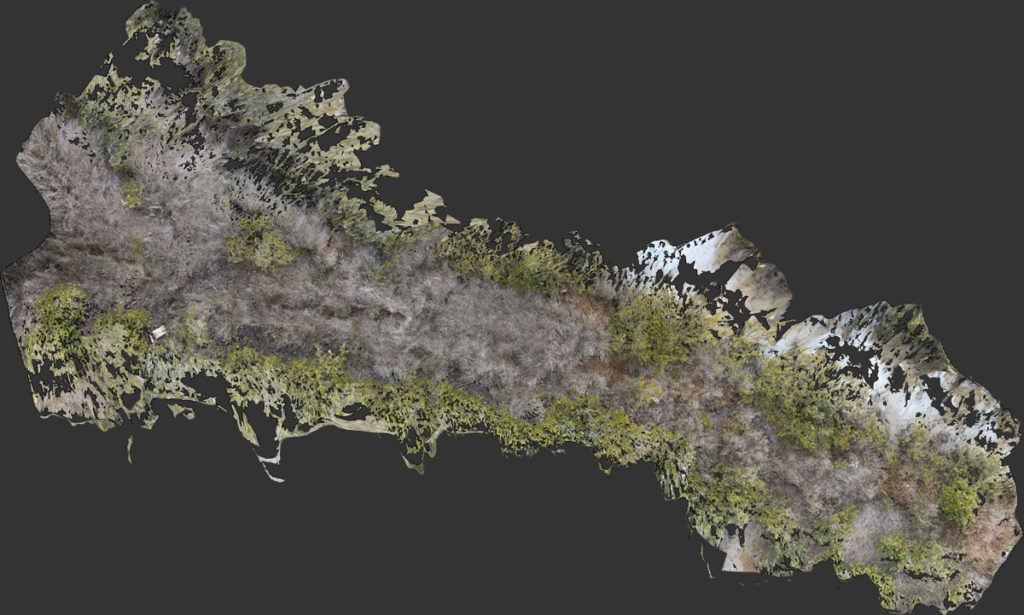
The differences between above and below water are: Camera distance to subject, flotsam, visibility / image quality and colour range. If the footage I am gathering is too poor for Metashape to align it might mean we need less suspended sediment in the water to make the images. That’s a problem as the places I want to map are suffering from suspended sediment – which is why they would benefit from shellfish restoration.
The Agisoft support team are awesome. They processed my footage with f = 1906 in the camera calibration, align photos without using preselection and a 10,00 tie point limit. The alignment took 2.5 days but worked perfectly (click on the image below). There are a few glitches but I think the result is good enough for mapping life on the seafloor. I will refine the numbers a bit and post them in a seperate blog post, wahoo!
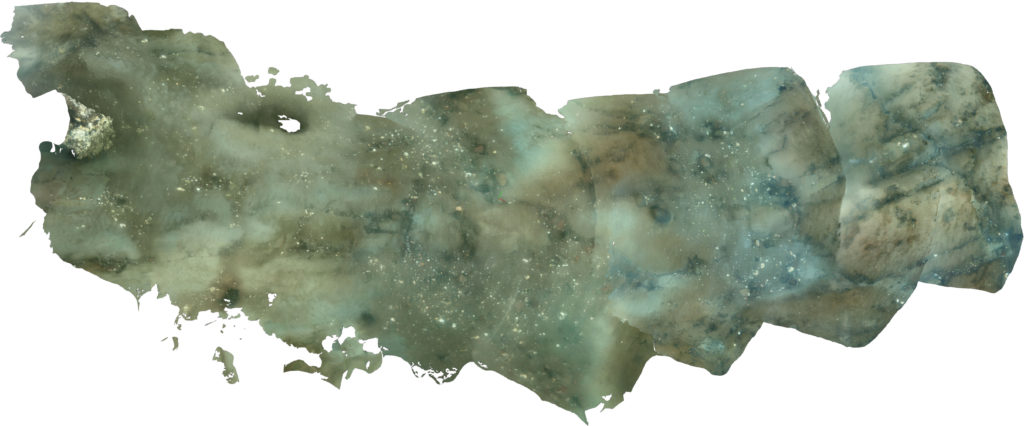
Update Jul 2022: Great paper explaining the process with more sophisticated hardware
Final method
Here is my photogrammetry process / settings for GoPro underwater. I am updating them as I learn more. Please let me know if you discover an improvement. Thanks to Vanessa Maitland for her help refining the process.

Step 1: Make a video of the seafloor using a GoPro
Step 2: Edit your video
Step 3: Install and launch Agisoft Metashape Standard.
Step 4: Use GPU.
Step 5: Import video
Step 6: Camera calibration
Step 7: Align photos
If 100% of cameras are not aligned then try Step 8 otherwise skip to Step 9.
Step 8: Align photos (again)
Now all the photos should be aligned, if not repeat step 7 & 8 with higher settings and check ‘Reset current alignment’ on step 7 only. I have been happy with models that have 10% of photos not aligned.
Step 9: Tools / Optimize Camera Locations
Just check the check boxes below (default settings):
Leave the other checkboxes (including Advanced settings) unchecked.
Step 10: Resize region
Use the region editing tools in the graphical menu make sure that the region covers all the photos you want to turn into a 3D mesh. You can change what is being displayed in the viewport under ‘Model’, ‘Show/Hide Items’.
Step 11: Build dense cloud
Step 12: Build mesh
Step 13: Build texture
Step 14: Export orthomosaic
You can orientate the view using the tools in the graphical menu. Make sure the view is in orthographic before you export the image (5 on the keypad). Then chose ‘View’, ‘Capture View’ from the menu. The maximum pixel dimensions are 16,384 x 16,384. Alternatively you can export the texture.
==
Let me know if you have experimented converting timelaspe / hyperlapse video to photogrammetry. There may be some advantages.
As communities get increasingly worried about the declining quality of their waterways there is more interest stream health assessments. I am a huge fan of the Waicare Invertebrate Monitoring Protocol (WIMP) which is simple enough that school students can use it. However the Waicare programme has been largely defunded by Auckland Council and there is no way for the public to share WIMP data. NIWA and Federated Farmers of New Zealand have put together https://nzwatercitizens.co.nz/ based on the New Zealand Stream Health Monitoring and Assessment Kit (SHMAK). It is great but incredibly hard to use, the manual is horrific. I believe this is being addressed but will take years. To help, the science learning hub has made this great guide for teachers and students. NIWA have put together some videos. They are not published together anywhere online so I have posted the list below:
I really like this list of alternative words for environmental terms, offered by George Monbiot & Ralph Steadman. I have rebuilt it in HTML with some additions and deletions, I plan to evolve it over time.
| Existing terms | What’s wrong with it | Alternative terms |
| Environment | Cold, technical Seen as seperate | The natural world |
| Global warming | Warm sounds pleasant | Global overheating |
| Biodiversity | Inaccessible | Wildlife |
| Ecosystem services | Anthropocentric and reductive | Life support systems |
| Nature reserve | ‘reserve’ suggests coldness | Wildlife refuge |
| Habitat destruction Deforestation Biodiversity loss | Sounds like they are happening to themselves | Ecocide |
| Conservation | Preserving what little is left rather than rebuilding living systems (New Zealand needs a department of Restoration) | Restoration |
| Clean rivers / seas | Sounds too hygienic, is blind to waters as habitats | Thriving rivers / seas |
| Fossil fuels | Suggests redundancy | Dirty fuels |
| Sustainable development | Green growth is an oxymoron | Regenerative development |
| Photopollution | Too technical, doesn’t indicate what is being impacted | Ecological light pollution |
| Stormwater | Suggests that the water is unwanted, unnecessary or unsavoury | Rainwater |
| MARINE | ||
| Fish stocks | Suggests fish are here to serve us | Wild fish populations |
| Biofoul, foul, foul ground | Suggests there is something ugly about biogenic habitats | Sea life, seafloor life, benthic epifauna |
| Fishing | Casual everyday activity | Killing native wildlife |
| Bait fish | Implies the fish exist to be bait | Small schooling fish / forage fish / small pelagic fish / shoaling fish |
| Bait ball | Implies the fish exist to be bait | Tight ball of fish |
| Seaweeds | Pest connotations | Ocean plants |
| Mobile bottom contact fishing | Implies a light touch | (Mobile) Bottom impact fishing |